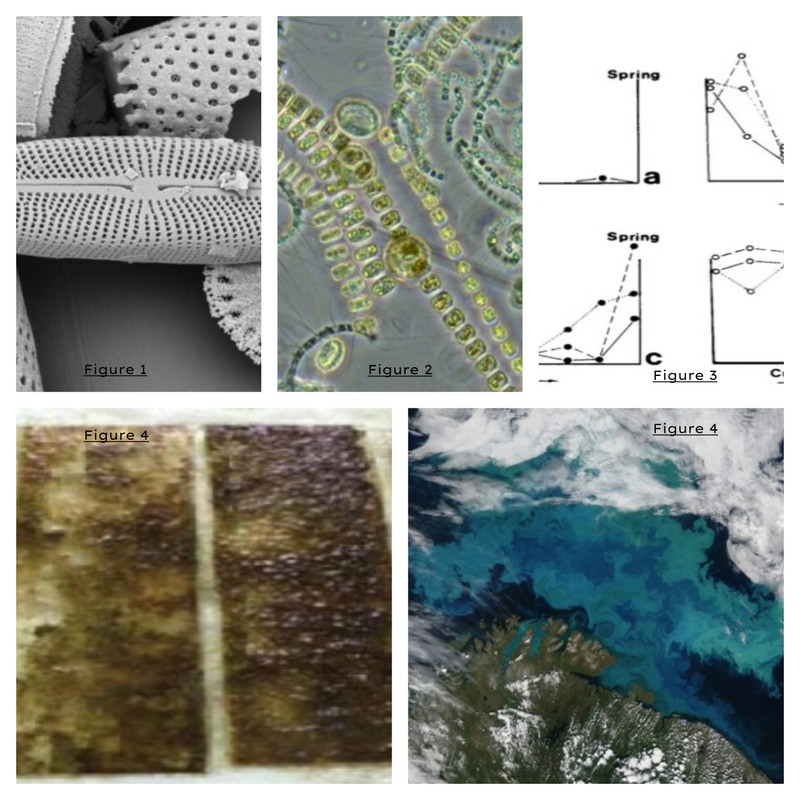
DIATOMS - A GAME CHANGER
- By Mr. Manisha Rajendrabhai Bodgal
ABSTRACT
In this article we are going to review about how diatoms play the significant role of game changer in perspective of environment and climate change and its contribution in global biogeochemical cycling because of its dependency on several important environmental factors such as pH, salinity, nutrient concentration, suspended sediments, flow regime, elevation and different types of human disturbance. Diatoms help in the global oxygen production, is important part of the marine food web and carbon sequestration ( process of capturing and storing atmospheric carbon dioxide )
INTRODUCTION
Diatoms are the unicellular, eukaryotic algae which are photosynthetic in nature. They have cellwalls made up of silica and the outer cellwall is called the frustule. Diatoms belong to phylum Gyrista of kingdom Chromista. Its scientific name is Bacillariophyceae. Diatoms arose about 200 million years ago and their continuous evolution has resulted in various mechanisms to adapt the environmental changes. They have colonized, freshwater, marine, and terrestrial habitats with different shapes, sizes and different physiological characteristics. Their cell size ranges from 2µm to 500µm (0.5mm). Diatoms are the most diverse protists on the earth as they have species ranging upto 20,000 to 2 million and scientists are discovering new species every year.
Figure 1 https://diatoms.org/images/page_images/_crop655x450/Adlafia_ME-HP002_042618_mix_002.jpg
Figure 2 https://diatoms.org/images/page_images/_crop655x450/Anderson2.jpg
DISCUSSION
Diatoms affect climate on a global scale. As they are photosynthesizing in nature, they breathe in carbon dioxide from atmosphere and are converted into organic carbon in the form of sugar and oxygen is released. Diatoms are responsible for 50% of photosynthesis taking place on earth. They generate 20% of the oxygen and contribute nearly half of the organic material found in the oceans. When the diatoms die, they sink to the ocean floor, burying the carbon and locking it away for 1000 years. Marine diatoms are major primary producers responsible for up to one fifth of the global carbon fixation. The levels of CO2 rise due to which the amount of carbonate decreases in the oceans and affects the ability of diatoms to store sufficient amount of iron for growth. Jeff McQuaid in his study said that “In these regions, high concentrations of atmospheric CO2 could decrease phytoplankton growth, restricting the ability of the ocean to absorb CO2 and thus leading to even higher concentrations of CO2 accumulating in the atmosphere.”
Diatoms are the source of energy rich molecules that feeds the oceans, rivers and lakes. It produces long chain fatty acids that are food for entire food web from zooplankton to aquatic insects to small fishes to whales. Diatoms are consumed by tiny animals called zooplankton and zooplankton sustain larger organisms like fishes so many animals depend on diatoms directly or indirectly for their survival in the ocean. They are responsible for 40% of the marine primary productivity and form a substantial basis of marine food web. Diatoms are key source of food and energy for organisms of freshwater ecosystems like snails, caddis fly larvae, small crustaceans and filter feeders like clams. Importance of diatoms is majorly due its place at base of the marine food chain and changes in their population can be an indicator to excessive population of other species in oceans. A study was conducted where the researchers inserted a mutated copy of a gene into diatoms to testify how the cells responded to changing ocean chemistry. The research centered on two common methods of iron take-up by diatoms and Professor Andrew E. Allen noted the impacts of acidification on diatoms and the research concluded that by year 2100 the iron uptake by primary mechanism will be decreased by 45% and will be dangerous as the secondary mechanism is more energetically expensive and will be less efficient. Professor Allen said that “if you take away any one kind of substrate there could be ripples through the microbial food web.”
The health of human population is connected directly to the health of oceans and climate. Commercial fishing is flourishing in many communities worldwide and has become main reason for nourishment and employment. The fish population will be imbalanced due to decrease in diatoms and thus risking the commercial fishing and will have huge impact on mankind. Scientists have raised concerns on the hole in the ozone layer as the harmful ultraviolet rays can have negative impact on the diatoms. They are also harmed by pollutants in the ocean and they are at risk from changes in global climate to wind patterns.
One of the features of diatoms is their silica-based shells. When diatoms die, their shells fall to the bottom of the body of water they inhabit and accumulate as sediment. Biologists can use this sediment to trace the water quality in an ecosystem by using it to determine the type and abundance of diatoms both now and in the past. Sometimes diatom shells in seafloor sediment can become diatoms over time. Some ancient diatom deposits that were once sediment on the sea floor are now dry land. Diatomaceous earth mined from the deposits has a wide range of important uses in industrial purposes as a filter and abrasive; some organic gardeners use it to control pests. Diatoms packed under sediment can also compress over time to form oil, so diatoms are indirectly responsible for much of the fuel we burn in our cars today.
Diatoms tell us about the health of aquatic systems. Samples of diatoms are collected from freshwater and marine sites. These samples are put through series of processes and the species of diatoms can be determined from its silica skeleton to provide an assessment of the water quality conditions over time. The data acquired can be further analyzed to determine the nutrient content, acidification, salinity, pH and more about the aquatic systems. This is useful for understanding the effects of outflows from sewage works or any impact of accidental discharge. Diatoms are sensitive to inorganic nutrient concentrations in water and their sensitivity differs on the basis of their different species. For example the species of Gyrosigma Acuminatum are more likely to be present under nutrient rich conditions. The Trophic Diatom Index (TDI) for an aquatic system can be calculated by measuring the following factors. If the TDI value is high then it indicates higher nutrient levels of the aquatic system. For sites where problem of acidification arises, for example any upland areas, then there is different index measured on the basis of sensitivity to changes in pH value and the index is labeled as the Diatom Acidification Metric (DAM). Diatoms are also used to inform about the pollution incident assessment, baseline surveys, general water quality monitoring and more about any particular site.
Figure 3 https://themeaningofwater.files.wordpress.com/2018/06/transectsacrossslide.jpg?w=640
There are different uses of diatoms like ancient Greeks used diatoms to make building materials, like bricks and blocks. Later it become popular in Europe for various industrial purposes. The various industrial purposes are removing unwanted material from drinking water, to prevent formation of lumps in foods, medicine, paints, plastics, used to clean up spills or for insulation in industry, used in scrubbing purposes, used in various parts of chemical tests, and also used in manufacturing of insecticide ( used to kill insects by dehydrating them or drying them out ). Diatoms are also used in various medicinal purposes such as for treating high cholesterol levels, for treating constipation, for improving the health of skin, nails, teeth, bones, and hair. It is used to remove unwanted dead skin cells. Forensic uses of diatoms are based on the principle that diatoms can be detected in the organs of drowned victims if they inhaled diatom rich water into the lungs before the death occurred. The Forensic Limnology is a field of forensic science which deals with the study of freshwater ecology for presence of diatoms in order to solve forensic and medical cases. It can also help in tracing the location of site of drowning as diatoms are very collective in nature and their occurrence and are very specific to locations. Using the application of diatom fingerprinting we can also determine the time of drowning.
Figure 4 diatoms used in testing purposes https://themeaningofwater.files.wordpress.com/2018/06/periphyton-covered-slides.jpg?w=326&h=220
CONCLUSION
Diatoms which are also referred to as living glass houses are crucial in many ways and its presence and absence both can have a huge impact and can be a game changer in the life of entire human kind. Diatoms have wide range applications such as oil exploration, forensic examination in cases of drowning, environmental indications, bio silica pattern generations, toxicity testing and eutrophication of aquatic eco systems. Scientists are conducting studies worldwide in order to trace the populations of diatoms by tracking the change in color of seawater from blue to green due to increase in density of diatoms. Scientists are adapting new technologies in order to determine the health and growth rate of diatoms using the NASA Satellite Imagery. The goal is to understand the tiny organism which plays essential role and is vital to life on earth.
Figure 5 satellite view https://diatoms.org/images/news_images/_max600/Barents_Sea_plankton_2011226.jpg
REFERENCES
• https://www.mdpi.com/2073-4441/13/4/478
• https://www.apemltd.com/what-are-diatoms-and-what-can-they-tell-us-about-water-quality/
• https://sciencing.com/different-types-phytoplankton-5082252.html
• https://globalchange.mit.edu/news-media/jp-news-outreach/diatoms-capacity-store-carbon-deep-ocean-underestimated
• https://www.smh.com.au/environment/climate-change/game-changer-new-vulnerability-to-climate-change-in-ocean-food-chain-20180314-p4z4cg.html
• https://themeaningofwater.com/2018/07/21/diatoms-in-the-time-of-climate-change/
• https://diatoms.org/news/does-climate-affect-diatoms
• https://diatoms.org/what-are-diatoms
Written BY:
Manisha Rajendrabhai Bodgal [Intern ID– AFRS_IP2326]
BSc. Forensic Science
National Forensic Sciences University
